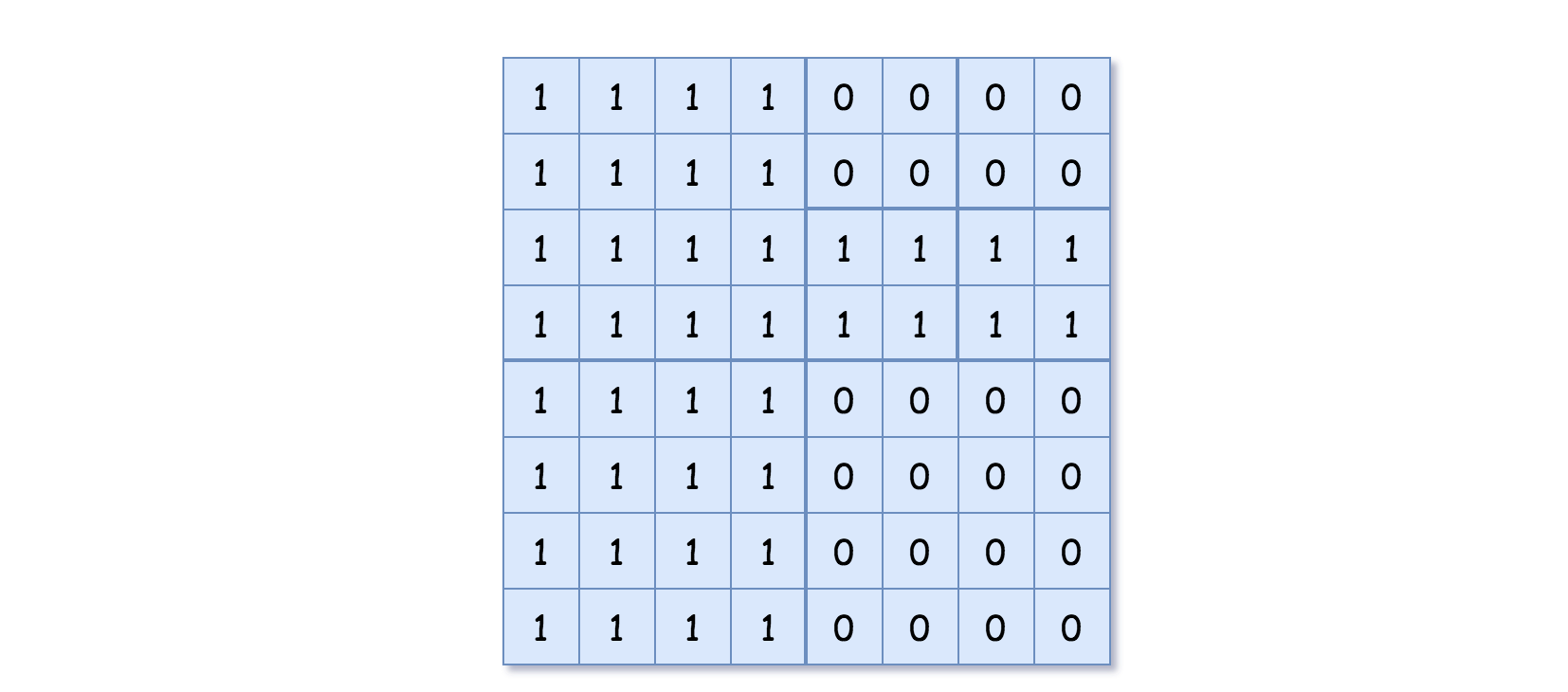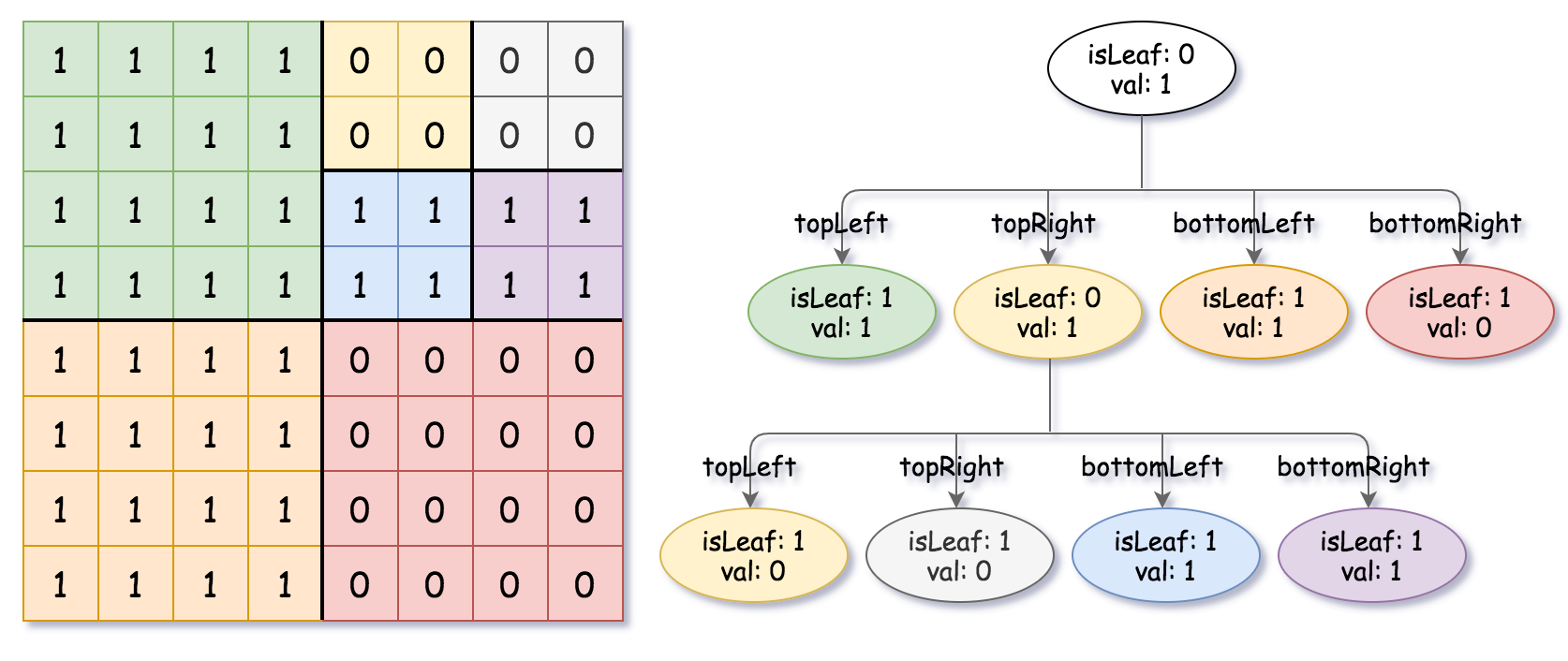Given a?n * n?matrix?grid?of?0's?and?1's?only. We want to represent the?grid?with a Quad-Tree.
Return?the root of the Quad-Tree?representing the?grid.
Notice that you can assign the value of a node to?True?or?False?when?isLeaf?is?False, and both are?accepted?in the answer.
A Quad-Tree is a tree data structure in which each internal node has exactly four children. Besides, each node has two attributes:
val: True if the node represents a grid of 1's or False if the node represents a grid of 0's.isLeaf: True if the node is leaf node on the tree or False if the node has the four children.
class Node {
public boolean val;
public boolean isLeaf;
public Node topLeft;
public Node topRight;
public Node bottomLeft;
public Node bottomRight;
}
Example 2:

Input: grid = [[1,1,1,1,0,0,0,0],[1,1,1,1,0,0,0,0],[1,1,1,1,1,1,1,1],[1,1,1,1,1,1,1,1],[1,1,1,1,0,0,0,0],[1,1,1,1,0,0,0,0],[1,1,1,1,0,0,0,0],[1,1,1,1,0,0,0,0]] Output: [[0,1],[1,1],[0,1],[1,1],[1,0],null,null,null,null,[1,0],[1,0],[1,1],[1,1]] Explanation: All values in the grid are not the same. We divide the grid into four sub-grids. The topLeft, bottomLeft and bottomRight each has the same value. The topRight have different values so we divide it into 4 sub-grids where each has the same value. Explanation is shown in the photo below:

思路:DFS,如果四个node全部是isLeaf,那么直接返回node,否则继续递归;
/*
// Definition for a QuadTree node.
class Node {
public boolean val;
public boolean isLeaf;
public Node topLeft;
public Node topRight;
public Node bottomLeft;
public Node bottomRight;
public Node() {
this.val = false;
this.isLeaf = false;
this.topLeft = null;
this.topRight = null;
this.bottomLeft = null;
this.bottomRight = null;
}
public Node(boolean val, boolean isLeaf) {
this.val = val;
this.isLeaf = isLeaf;
this.topLeft = null;
this.topRight = null;
this.bottomLeft = null;
this.bottomRight = null;
}
public Node(boolean val, boolean isLeaf, Node topLeft, Node topRight, Node bottomLeft, Node bottomRight) {
this.val = val;
this.isLeaf = isLeaf;
this.topLeft = topLeft;
this.topRight = topRight;
this.bottomLeft = bottomLeft;
this.bottomRight = bottomRight;
}
};
*/
class Solution {
public Node construct(int[][] grid) {
return helper(grid, 0, 0, grid.length);
}
private Node helper(int[][] grid, int x, int y, int len) {
if(len == 1) {
return new Node(grid[x][y] == 1, true, null, null, null, null);
} else {
Node node = new Node();
Node topLeft = helper(grid, x, y, len / 2);
Node topRight = helper(grid, x, y + len / 2, len / 2);
Node bottomLeft = helper(grid, x + len / 2, y, len / 2);
Node bottomRight = helper(grid, x + len / 2, y + len / 2, len / 2);
if(topLeft.isLeaf && topRight.isLeaf && bottomLeft.isLeaf && bottomRight.isLeaf
&& topLeft.val == topRight.val && topRight.val == bottomLeft.val && bottomLeft.val == bottomRight.val) {
// 如果四个node,分别都是叶子节点,而且value全部相同,那么这个大的node就是个叶子节点;不用再递归了;
node.isLeaf = true;
node.val = topLeft.val;
} else {
// 否则,那这个node的四个node还需要用递归结果;
node.topLeft = topLeft;
node.topRight = topRight;
node.bottomLeft = bottomLeft;
node.bottomRight = bottomRight;
}
return node;
}
}
}